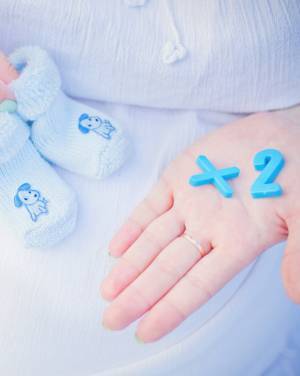What Does it Mean to Be a High-Risk Pregnancy?
- A pregnancy is categorized as high-risk under specific conditions such as advanced maternal age, expecting multiples, or a diagnosis of gestational diabetes.
- A high-risk diagnosis is a means of providing closer monitoring as it allows for additional prenatal check-ups.
- The term "high-risk" pregnancy may sound unsettling. Nevertheless, the vast majority of high-risk pregnancies and births are free from complications.
Do you have any questions or concerns? Write your message directly here ⬇️
Factors: What Qualifies as a High-Risk Pregnancy?
Some pregnancies receive more frequent and comprehensive medical care to ensure early detection and prevention of possible complications. This involves closer pregnancy monitoring to assess potential risks.
Certain factors classify a pregnancy as high risk:
- The pregnant woman's obstetric and medical history may play a role.
- Current factors or diagnoses can increase the chance of complications.
💬 You will be asked about preexisting medical conditions during your first prenatal appointment. All relevant information will then be entered into your maternity file. Ask your doctor about any red flags and whether there are any specified instructions for you.
What Makes a Pregnancy High Risk?
-
- Chronic health concerns (e.g., kidney or liver disease, diabetes, lupus, thyroid disorder)
- Family history of disorders such as blood clots or hemophilia
- Fertility treatments or sterilization
- Previous miscarriage or stillbirth
- Complications in previous pregnancies (e.g., fetal growth restriction, preeclampsia)
- Advanced maternal age (over 35) or adolescent pregnancy (under 17)
- High prepregnancy BMI (35 or above) or underweight mothers (lower than 18.5)
-
- Expecting multiples
- Gestational diabetes/hypertension
- Preeclampsia
- Fetus measuring larger or smaller than average
- Fetal anomalies
- Malpresentation: The baby is not in the correct position for birth
- Placenta previa (Placenta is too low) or vasa previa
- Preterm labor/risk of preterm birth
- Substance use (5 or more drinks per week or polysubstance use)
Any immediate concern during pregnancy that could cause pregnancy complications is given greater attention than health history concerns.
- 🧑⚕️ (Suspecting a) pregnancy – How soon to see a doctor? Take the quiz!
- 🍷🚬 Tobacco/alcohol/drugs: Has my consumption hurt the baby? Test
- 🤱 Pregnant again after a C-section: Is it too soon? Find out by taking the test.
What Age Is Considered a High-Risk Pregnancy?
The age range for high-risk pregnancies differs slightly from country to country. While your pregnancy falls under the high-risk category if you are under 17 or over 35 in the US, the high-risk age range in the UK is under 19 and over 40. The reason for the variation is that these are not abrupt cut-off dates beyond which pregnancies are expected to be wrought with complications. Rather, it describes a gradual continuum in which the chance of experiencing problems increases.
Advanced Maternal Age
The primary reason 35-year-olds and above fall under the high-risk category is that, statistically, certain risks increase with age. As the woman's body and her fertility undergo changes, she is at higher risk of experiencing a miscarriage, premature delivery, gestational diabetes, or thrombosis.
And yet, complications such as fetal defects are still the exception. Also, miscarriages due to advanced maternal age usually occur early in pregnancy and often go unnoticed.
Many women are concerned about being considered of advanced maternal age at 35. Since the median childbearing age in industrialized nations is steadily pushed back, a pregnancy at 35 is becoming increasingly frequent.
But this status also ensures early intervention regarding corresponding risk factors. Your doctor will keep a closer eye on specific readings or increase the number of check-ups. In this way, complications can be averted or detected in time.
ℹ️ Because of the multitude of possible factors, many pregnancies are categorized as high risk. Knowing that it is very common to be classified as having a high-risk pregnancy will hopefully provide some reassurance. The goal is for you and many other women to receive the best medical care possible.
📗 for more information, go to:
Teen Pregnancy Risks
The risks of preterm labor and premature birth slightly increase in adolescent women — depending on their physical maturity. Therefore, pregnant teens under 17 fall into the high-risk category. At the same time, a younger age usually means greater vitality and health.
So, the term high-risk pregnancy need not cause concern. Instead, it serves the purpose of keeping close tabs on the pregnancy to ensure that you and the baby are doing well.
Our tip: You may find it reassuring to ask someone from your circle to come with you to your check-ups.
🙎♀️ Pregnant and dealing with unanswered questions?
 430419526 | Ground Picture | shutterstock.com
430419526 | Ground Picture | shutterstock.com
A high-risk pregnancy does not necessarily mean that complications are to be expected. Regular check-ups provide reassurance and assess possible risks.
High-Risk Pregnancy with Multiples
A multifetal gestation is also considered high risk. This means that once it becomes apparent that you are expecting multiples, your pregnancy will be monitored more closely. This is because certain risks increase, more so in the case of identical twins, especially if the babies share the same amniotic sac or placenta.
Multiples are also usually born before their due date. Of course, their combined weight is higher than a singleton, exerting increasing pressure on the cervix. This can lead to cervical insufficiency or preterm delivery.
Regular check-ups allow for the pregnancy to be monitored more closely. Good medical care is a solid foundation for a smooth multi-gestational pregnancy and delivery.
👧🏻👧🏻 For more information, go to:
High-Risk Pregnancy Care
Your doctor usually decides which additional evaluations may be beneficial on a case-by-case basis and will discuss this with you. These may include the following:
Ultrasound and Fetal Nonstress Test
In addition to the 20-week ultrasound, further scans or more extensive screenings may be scheduled to monitor risk factors. Weekly ultrasounds are commonly performed after 32 weeks when encountering a higher risk for premature birth.
Nonstress tests (NSTs), aka cardiotocography, are frequently performed in the third trimester of high-risk pregnancies. Here, the baby's heart rate is measured while the baby is resting, moving, and exposed to possible contractions to ensure that the baby is responding well.
Medication and Dietary Restrictions
Your doctor may prescribe medication to help deal with the symptoms of a high-risk pregnancy. You may also be required to rest more frequently. If you are diagnosed with gestational diabetes, a dietician will explain how to adapt your diet.
Prenatal Diagnostic Testing
If your medical provider suspects that your baby may have an infection, they may take an umbilical blood sample, aka cordocentesis, for testing.
Your doctor may suggest other prenatal diagnostic tests to rule out hereditary diseases. Invasive DNA tests use placental tissue samples (chorionic villus sampling) or amniotic fluid (amniocentesis).
Since these examinations carry risks, seek expert advice, and take the time to weigh all your options.
Gestational Diabetes
Gestational diabetes is a pregnancy condition in which the mother does not produce sufficient insulin resulting in a rise in blood sugar levels.
Gestational Diabetes Screening
Gestational diabetes screenings are routinely performed in every pregnancy — regardless of whether you are high-risk or not. This one-hour glucose challenge test is performed between weeks 24 and 28. The screening is completed by taking a sample of blood on an empty stomach, after which you are given a 10 oz glucose drink. Your blood is drawn again and compared to the first sample one hour later. Abnormal screening results are not a diagnosis. 40% of patients who fail this test do not have gestational diabetes. Further testing is needed to determine whether your body produces sufficient insulin.
Gestational Diabetes Testing
A three-hour oral glucose tolerance test (OGTT) is scheduled if your screening results show that your blood sugar levels are high. Here, the sugary drink is given in three hourly intervals, between which blood is taken a total of four times. If more than two results are elevated, a gestational diabetes diagnosis is given.
Once a diagnosis is confirmed, the pregnancy would be classified as being at risk for certain complications, such as delayed fetal lung maturation. Additionally, the mother’s elevated blood sugar levels usually lead to greater birth weight and size (macrosomia), potentially extending the birthing process and thereby delaying postpartum care.
In addition, gestational diabetes increases the risk of preeclampsia. Therefore, blood sugar levels and blood pressure are monitored regularly to make early intervention possible.
I Have Gestational Diabetes — Now What?
If you are diagnosed with gestational diabetes, your doctor, midwife, or dietician will teach you how to adjust your diet. Avoiding certain foods can prevent your blood sugar level from fluctuating too much. Focus on foods with low glycemic index. Exercise and regular meals also help to keep blood sugar levels in balance. Your doctor may also prescribe insulin to keep your diabetes under control. Taking these measures will support a healthy fetal weight gain.
Having type I or II diabetes does not necessarily lead to gestational diabetes.
Having gestational diabetes does not necessarily mean that you will develop type II diabetes after delivery.
👍 Tip: If experiencing extreme thirst or bladder infections before the third trimester, you may be tested for diabetes sooner.
Pregnancy-Related Medical Leave
Falling under the high-risk category does not automatically mean that you need to take sick leave. In most cases, this will not interfere with your work activities. As for any pregnancy, you can request accommodations since pregnancy is a protected status. Your employer must comply with federal regulations to keep your workplace and workload safe for you and your baby.
If your work is incompatible with pregnancy or you need more rest because of a high risk of premature birth, you may have to take sick leave. Fortunately, financial support is available.
Bedrest — Now What?!
Especially if it comes to pregnancy complications, trust your doctor's advice to rest as much as possible. Sometimes, partial or full bed rest is prescribed to decrease the amount of pressure on your cervix. Wondering how to manage life while on bedrest? Practical support is available!
💡 For more ideas, go to KeepEmCookin, Better Bedrest, or the Preeclampsia Foundation.
High-Risk Pregnancy — Worried About the Baby
Perhaps you found our page because your pregnancy is in the high-risk category. For many women, this classification initially triggers concern. "Risk" does sound alarming.
You may also be worried about your baby because of other at-risk pregnancies you witnessed or experienced. Or perhaps you are already encountering some complications.
You may also be dealing with other concerns right now, and this diagnosis is adding to your worries. The cumulation of these apprehensions can easily lead to emotional upheaval and mental exhaustion. Are you tired of feeling tense and anxious and wondering how to shake this uneasiness?
🧑⚕️You may find it helpful to talk to your doctor or midwife about your concerns. Discuss which measures you can take to diminish the risks as much as possible. If you do not feel well taken care of, consider getting a second opinion or even switching doctors. A good relationship with your medical provider can significantly affect your emotional well-being.
💚 In addition to receiving excellent medical care, spending time with people you feel close to may help you feel more at ease. Also, take time for self-care by doing things you find relaxing or rejuvenating — cultivating a sense of hopefulness.
We are also here for you! Especially when you feel unsure. Allow us to be your sounding board as you think through your what-ifs.
- What are my hidden strengths? 💪 Strengths Finder Test
- What is my pregnancy personality? 👥 Personality Test
















